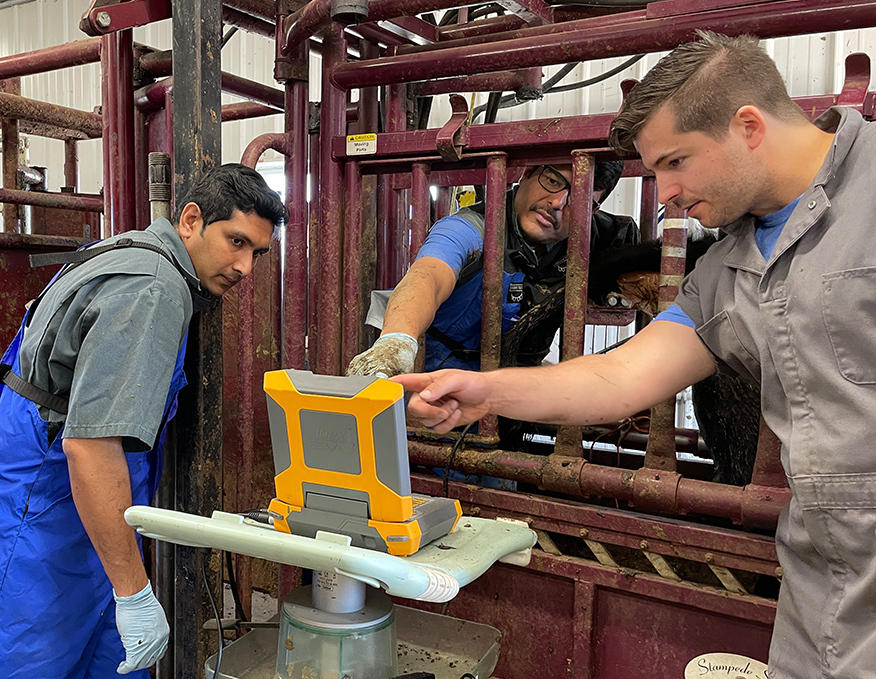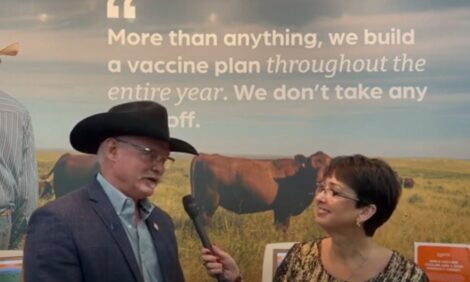



Scientist to expand reproductive dairy health research to beef cattle
A University of Saskatchewan veterinarian is exploring how research into the reproductive health of dairy cows as well as emerging technologies can be applied to beef cattle
“I think there are some clues on the dairy side that have been ignored on the beef side,” said Dr. Dinesh Dadarwal (DVM, PhD, Diplomate ACT), an assistant professor in the Department of Large Animal Clinical Sciences at the Western College of Veterinary Medicine.
While Dadarwal is focused on cattle research, animal science wasn’t always his passion. He remembers weighing his options between becoming a physician and a veterinarian. As a child being raised in Hisar, a city in India, he expected he would become a medical doctor, but spending every summer at his family’s farm kept drawing him to the animal world.
“I still remember the first class I had in veterinary school. It was in anatomy. I thought, ‘This is it! I’m not going anywhere,’” said Dadarwal enthusiastically in an interview.
“My interest just grew. There are so many species to work with. It keeps me on my toes.”
Dadarwal’s experience spans a wide range of animals. In India, his extended family continues to raise water buffalo, cows, camels, sheep and goats. Professionally, he has worked in a small animal clinic in India, caring for pets and stray animals, and he has conducted research on donkeys. He currently conducts research on dairy cows as well as beef cattle and sheep.
In 2007, Dadarwal started his PhD work at USask, focusing on cattle reproductive health. After he completed his PhD in 2012, he returned to India to teach before returning to USask as a resident. During his post-doctoral residency, he narrowed the focus of his work in theriogenology, a specialty of veterinary medicine concerned with animal reproduction. He continues his research into the post-partum uterine health of dairy and beef cows.
Dadarwal is committed to ensuring the health and wellbeing of all the animals that he studies with an eye to improving animal production and profitability.

Within the first week after a cow calves, it’s normal for the animal’s uterus to be enlarged, inflamed and infected with bacteria. Three things need to happen to prepare the animal for breeding again. Immediately after the birth, the uterus is about 10 kilograms. It needs to shrink to about one kilogram. The bacteria need to be cleared out and the lining of the uterus needs to be repaired.
Research has shown that between 20 and 50 per cent of dairy cows develop inflammation that continues into the fourth, fifth and sixth week after calving. The dairy cows with this sustained inflammation tend to have a lower conception rate in the next breeding season, says Dadarwal.
“It’s one thing that the uterus is not healthy enough to support the next pregnancy but even if that animal gets pregnant somehow, it will lose that pregnancy.”
Dadarwal wants to know if this is more common with dairy cattle than with beef cattle. Dairy cows are bred and raised for high milk production where beef cows are bred to raise a calf, usually while the pair is on pasture.
“Are we creating two different populations? Beef cows are not pushed metabolically. They are not diverting all their nutritional resources to milk production. Are they able to balance it out compared to dairy cows? Can we use that beef cow as a low-metabolic stress model to study uterine health? What happens if you put a beef cow into metabolic stress and how does that affect fertility?”
Dadarwal’s multi-year study, funded by a Natural Sciences and Engineering Research Council of Canada (NSERC) Discovery Grant, will be conducted at the Livestock and Forage Centre of Excellence and at the Rayner Dairy Research and Teaching Facility. He will compare inflammation and fertility of mother-daughter pairs and unrelated older and younger cows in both beef and dairy herds. He will also be examining the bacteria itself.
“Bacteria involved in the inflammation in the dairy cows in the post-partum period are commensals that are in the uterine tract all the time. What are the conditions that made the bacteria decide to cause sustained inflammation?”
Dadarwal is hoping to develop a tool or a test that would help beef producers identify cows that have sustained inflammation so they can cull these animals from their herd. He also hopes to learn if mother-daughter pairs respond the same or differently after having a calf. Ultimately, beef producers want to raise healthy cows that produce healthy calves as that is their source of income. Dadarwal’s research could result in the development of selection criteria, increasing the profitability of beef producers.
Producers need to consider their return on investment, whether it’s selecting breeding animals or implementing emerging technologies as part of their management strategies. While companies develop and market artificial intelligence applications for the cow-calf industry, these applications often aren’t validated by a third party.
“The key thing is the price. As long as the cost is not prohibitive for these capital inputs, if you have an algorithm that can identify cows that are lame or calving or having problems calving and have that send you a text message, that’s a pretty good thing,” said Dadarwal, who will be a collaborator on a smart-tech research project with Dr. Jaswant Singh (BVSc, PhD), a Western College of Veterinary Medicine professor.
Data will be collected three ways: video surveillance, ear tags with GPS tracking and tail sensors.
“We will try to compare visual observation with the camera system with the ear tag system and the tail sensors that are out there for the calving. Can they somehow ‘talk’ to each other? That would be the perfect scenario.”
With experienced cow-calf workers in short supply, Dadarwal is hoping the research they are conducting will benefit the owners of cow-calf operations. The two-year study, beginning in the spring of 2024 at the LFCE, will be funded by the Saskatchewan’s Agriculture Development Fund.


